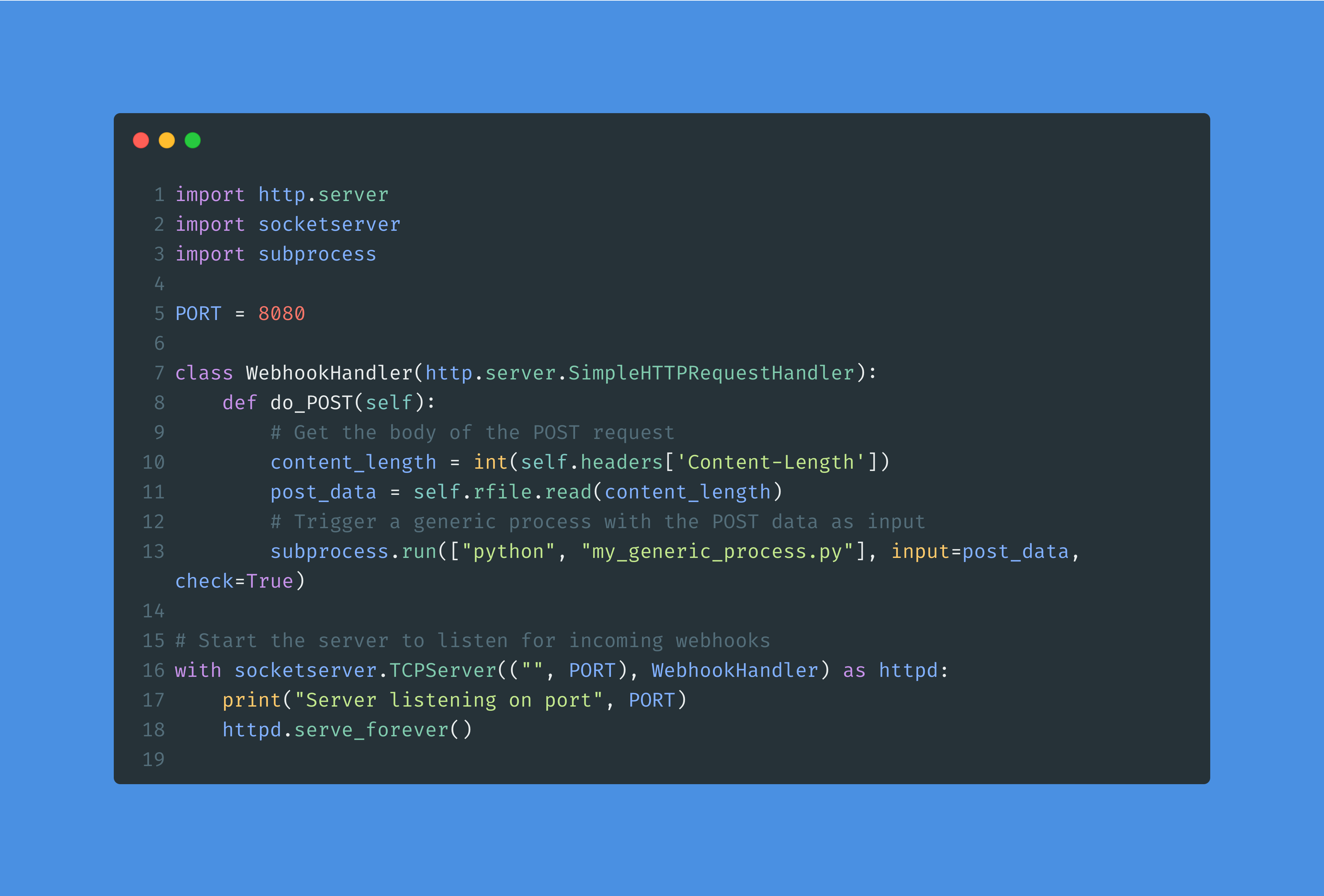IT Automation with Python
Learn More about IT Automation with Python and how it can help you and your company streamline repetitive workflows and increase efficiency.

With the time of your IT team at a premium, software developers need to be focused on coding projects that deliver value to the business instead of wasting time on coding repetitive workflows.
Automation with Python typically involves writing scripts or programs, and is used for a wide range of automation tasks like file manipulation, data scraping, web testing, system administration tasks, image processing, and more. Implementing IT automation with Python saves time, reduces errors, and increases efficiency in various industries and use cases, including software development, data science, research, data analytics, and more.
Benefits of Python Automation
Implementing IT automation with Python scripts is popular because of the programming language’s simplicity, intuitiveness, versatility, support of data structures, and powerful libraries.
Python is easier to read and comprehend than other programming languages for many because its syntax resembles English, and offers several ways to store data, including lists and dictionaries. Python also offers programmers the ability to create their own data structures, improving data management and automation responsiveness.
The Python programming language provides several modules and libraries that make automation easier, like the OS module for working with files and directories, the Requests module for making HTTP requests, and the Selenium library for automating web browsers. The large set of libraries offered by Python enable programmers to automate for goals related to operating system management, machine learning, and more.
Automation Using Python Scripts: Examples
- Manage CSV files from Excel: Comma Separated Values (CSV) is a file format for importing and exporting spreadsheets from Excel. Python can copy and store contents of a CSV file, which programmers can pull from to complete other tasks. This Python script reads and prints out the contents of a CSV file.
import os, shutil
lis = []
i = 1
destinationdir = '/Users/NAME/Desktop/Everything'
while os.path.exists( destinationdir ):
destinationdir += str(i)
i += 1
os.makedirs( destinationdir )
lis = os.listdir('/Users/NAME/Desktop')
for x in lis:
print x
if x == __file__:
continue
shutil.move( x, destinationdir )
- Make changes to your operating system: Using Python’s OS and shutil modules, programmers can allow Python to make changes to their device’s operating system, like renaming files, creating folders, etc. for better organizations. This Python script creates a folder titled “Everything” on a device’s desktop and moves all files into it.
import os, shutil
lis = []
i = 1
destinationdir = '/Users/NAME/Desktop/Everything'
while os.path.exists( destinationdir ):
destinationdir+=str(i)
i += 1
os.makedirs(destinationdir)
lis = os.listdir('/Users/NAME/Desktop')
for x in lis:
print x
if x == __file__:
continue
shutil.move( x, destinationdir )
- Bulk sending personalized emails: Python makes it extremely easy to send personalized emails to multiple recipients, which can be valuable for professionals in digital marketing, education, project management, e-commerce, and more. This Python script should be run after a CSV file has been created with recipient information.
import csv, smtplib, ssl
from datetime import date
today = date.today().strftime('%B %d, %Y')
message = "Subject: Your evaluation
Hi {name}, the date of your Q1 evaluation is {date}. Your score is: {score}"
from_address = 'YOUR EMAIL ADDRESS'
# You may need to create an app password for Gmail here: https://myaccount.google.com/apppasswords
password = input('Enter password: ')
context = ssl.create_default_context()
with smtplib.SMTP_SSL('smtp.gmail.com', 465, context=context) as server:
server.login(from_address, password)
# use a customers.csv file with name, email, and score columns
with open('customers.csv') as file:
reader = csv.reader(file)
for name, email, score in reader:
server.sendmail( from_address, email, message.format( name=name, date=today, score=score) )
Resources to Learn Python
Programmers looking for more information to learn Python code have many resources at their disposal, including online learning for Python fundamentals, beginner-level tutorials like the Python Crash Course for coders with no prior experience, next level online courses with quizzes on Coursera, and more educational opportunities for learners that want to earn a Python professional certificate.
Google IT Automation with Python Certificate on Coursera
The Google IT Automation with Python professional certificate program is among the free online courses available on Coursera. Learners will gain in-demand skills related to Python, Git version control and GitHub, troubleshooting and debugging techniques, configuration management, basic Python syntax, IT support automation by writing Python scripts, and more.
IT Automation Tools for Python
IT automation tools for Python allow IT support professionals to develop, manage, and automate processes from a single dashboard. IT process automation tools can be invaluable solutions for managing distributed IT environments with multiple vendors, diverse applications, and evolving business operations.
Simply automating tasks isn’t good enough; IT automation tools need to enable end-to-end workflow automation across an entire enterprise.
Orchestrate Automated Processes
ActiveBatch is an IT workload automation and enterprise job scheduling software that helps IT teams seamlessly integrate and orchestrate business process automation (BPA) jobs with features for monitoring and managing distributed applications and systems.
- Intelligent automation tools use machine learning to optimize resources
- Event-driven architecture supports a wide range of event triggers like email, tweets, etc.
- Customizable notifications help IT support teams improve SLAs
- Flexible scheduling ensures workflows run when needed
Seamless Integrations
ActiveBatch offers prebuilt connectors to enterprise applications as well as a low-code REST API adapter, giving IT teams the extensibility they need to expand automation across the entire enterprise. Use cases include:
- Secure File Transfer
- Automate IT Infrastructure
- Business Automation
- Data Center Support
With ActiveBatch’s centralized automation platform, IT teams can automate limitless endpoints across applications, servers and services, ensuring that automation can scale effortlessly with an evolving tech stack.
Frequently Asked Questions
IT automation with Python can help IT teams in numerous ways, including: configuration management, infrastructure provisioning, deployment and release management, monitoring and altering, data analysis and visualization, and scripting and testing.
Python can be used to automate the process of setting up and configuring servers, databases, networks, and virtual machines. This can save time and reduce errors that may occur during manual configuration.
The Python programming language can automate deployment and release management, helping ensure software releases are consistent and predictable, and the monitoring of IT systems like servers and applications, providing notifications when issues arise.
Python’s powerful data analysis capabilities help teams identify trends and anomalies in system performance and usage, and the programming language makes it easy to use workload automation to automate testing and scripting to save time and increase accuracy.
Learn how ActiveBath’s intelligent workload automation builds, monitors, and manages end-to-end IT business processes.
Python and Java are both popular programming languages that can be used for automation, but have some differences that make them more suitable for certain types of automation tasks.
Overall, Python is better for automation tasks that require ease of use, readability, and a large number of available libraries and frameworks, while Java is better for tasks that require high-performance, scalability, and platform independence.
Python has a simple and easy-to-learn syntax, with a focus on readability, making it easier to write and understand automation scripts. Java, on the other hand, has a more complex, verbose syntax.
Python has a large and active community that has developed numerous libraries and frameworks for automation, like Selenium for web testing and PyAutoGUI for desktop automation. Java also has a wide range of libraries and frameworks, but they aren’t as plentiful or as easy to use as Python’s.
Java is designed to be platform-independent, meaning automation scripts written in Java can run on any platform that supports the Java Virtual Machine (JVM). Python is also cross-platform, but it may require additional configuration management to run on certain platforms.
See how teams are orchestrating automated IT business processes with ActiveBatch.
The Google IT Automation with Python Professional Certificate program is highly regarded among the Coursera online courses that teaches learners how to use Python for automating IT tasks. The Python course is designed to provide students with practical, in-demand skills and knowledge that are highly valued by employers in the IT industry.
The certificate program is designed for beginner-level learners with little or no prior experience in programming. The program consists of six online courses that cover topics such as Python programming fundamentals, using Python to interact with operating systems, and automation of IT infrastructure and services. Learners who complete the program earn a Python professional certificate from Google.
For those interested in becoming a Python developer or pursuing a career in IT and want to learn Python and how to use it for automation, this free online course is definitely worth it.
Learn why ActiveBatch focuses on the function of workflows with production-ready Job Steps.







